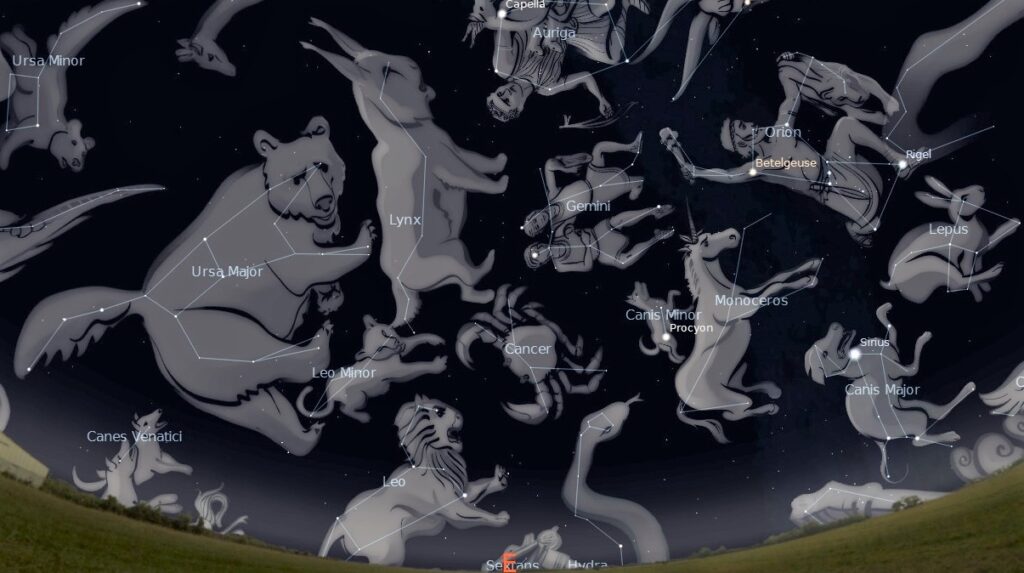This Week’s Sky at a Glance, 2022 December 24 – December 31 ~by Curt Nason
This week, check out the eastern sky around 10 pm to hunt down four dogs, three cats, two bears, a hare, a snake and a crab. Oh, and a unicorn if you believe in them.
Start looking toward the southeast where Orion is hunting. Below his feet is Lepus the Hare, staying immobile in hopes that Orion’s canine companions overlook him. Following Orion’s belt to the left brings you to sparkling Sirius at the heart of Canis Major the Big Dog, and it doesn’t take a great imagination to see a dog in this group of stars. Orion’s shoulders and head form an arrowhead that points toward bright Procyon, one of only a few visible stars in Canis Minor the Little Dog. Use your imagination to see Monoceros the Unicorn between the two dogs.
Now find the Big Dipper in the northeast. It forms the rear haunches and tail of Ursa Major the Big Bear, and from a rural area the legs and head of the bear can be seen easily. The two stars at the front of the bowl of the Dipper point northward to Polaris at the end of the handle of the Little Dipper, which is officially Ursa Minor the Little Bear. Below the handle of the Big Dipper are the two main stars and hounds of Canes Venatici the Hunting Dogs, seemingly nipping at the big bear’s butt.
Well below the bowl of the Big Dipper is Leo the Lion, recognized by the stellar backwards question mark of its chest and mane, with Regulus as its foreleg and a triangle forming its tail and hind legs. A faint triangle of stars between Leo and the Big Dipper is Leo Minor, the Little Lion. The third cat is Lynx, a faint line of stars running from Little Leo and past the front of Ursa Major. Between Regulus and Procyon is the head of Hydra the Water Snake, which will take much of the night to rise completely; and faint, crabby Cancer is above Hydra’s head.
This Week in the Solar System
Saturday’s sunrise is at 8:01 am and sunset occurs at 4:45 pm, giving 8 hours, 44 minutes of daylight. Next Saturday the Sun will rise at 8:03 am and set at 4:51 pm, giving 8 hours, 48 minutes of daylight.
The slim crescent Moon makes a tight triangle with Mercury and Venus low over the southwest horizon at 5 pm this Saturday, but binoculars will be needed. The Moon is at first quarter on Thursday evening when it pays Jupiter a visit. Mercury and Venus are paired up on Wednesday, with Mercury sitting half a binocular field above and Venus setting 75 minutes after the Sun. Mars is at its highest before 10:30 pm, and Saturn is setting around 8:30 so observe it early. On Tuesday a telescope will show Jupiter’s icy moon Europa disappear behind the planet at 6:17 pm, reappear on the other side at 8:53, and then disappear into the planet’s shadow 12 minutes later until it reappears at 11:34.
The Sunday Night Astronomy Show is taking a two-week vacation but you can watch previous episodes on the YouTube channel of Astronomy by the Bay. Better yet, if it isn’t cloudy pick out those critters in the night sky.
Questions? Contact Curt Nason

